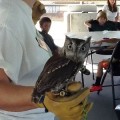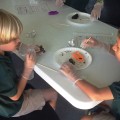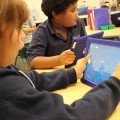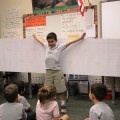NSU Newsroom
SharkBytes
Horizons
This version of NSU News has been archived as of February 28, 2019. To search through archived articles, visit nova.edu/search. To access the new version of NSU News, visit news.nova.edu.
This version of SharkBytes has been archived as of February 28, 2019. To search through archived articles, visit nova.edu/search. To access the new version of SharkBytes, visit sharkbytes.nova.edu.
Enriched STEM Education at University School
University School second grade students recently completed an integrated STEM exploration titled “Food, Feathers, and Flight.” Through the examination of owls and flight, the STEM unit merged learning standards in science, technology, reading, engineering, art, and mathematics.
Science lessons provided background information on food chains, food webs, and physical and behavioral adaptations of animals. Students learned that almost everything about the owl, its beak, talons, sight and hearing, feathers and digestive system, works together to make the owl a deadly and highly effective predator.
On a field trip to the Sawgrass Nature Center, students observed three species of owls and viewed their adaptations up close. Students also examined owl pellets, a by-product of the owl’s digestive process. Presleigh Osceola-Hahn found “rat bones, teeth, toes, and a tail” in the owl pellet she dissected. The center’s educational director provided many other examples of adaptations of various bird species, with a special emphasis on feathers and wing shapes. Sarafina Billie and her father, who also attended the field trip, were inspired after learning “so many interesting facts” about the different animals at the center that they adopted an egret.
In the life science component of the unit, students viewed wing feathers and body feathers under a microscope, they completed a writing piece comparing and contrasting the two kinds of feathers and they also used a computer-based app, “Build a Bird,” to combine different beaks, wings, and feet into one bird.
While exploring physical science concepts, students learned about the physical forces of flight and they completed demonstrations of lift and air pressure. Technology enhanced these concepts as students explored iPad-based flight simulators.
In class, students investigated the engineering process of scaling by scaling simple 2D figures and viewing a realistic scale model of a building. Students also discussed the wingspan-to-body size scaling aspect of a typical bird. In the engineering design lesson, small groups of students collaborated in the selection of materials and design to produce the “ultimate” paper airplane. This design activity applied instruction in the four forces inherent in flight: thrust, drag, lift, and weight. Noah Raisman knew that the wings of his airplane “had to catch air beneath them to make it go up” and upon testing his build, “it did it just right.” Student designs will be tested in early December in an all-grade “Flight Test Day.”
The multidisciplinary unit included reading about the Wright Brothers in social studies and chronicling on a timeline their efforts to engineer the first successful flying machine. For the art component of the unit students created a scale-model set of wings based on a student’s body size. Solving problems involving distances, speed, and travel time completed the math learning activities.
For more information about University School, please call (954) 262-4506 or visit us online at www.uschool.nova.edu/admissions.



